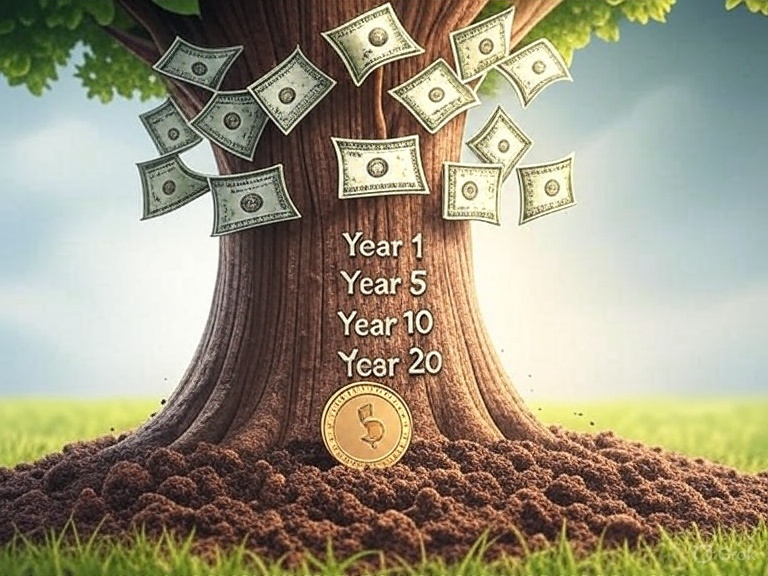When it comes to building wealth, there’s one silent hero that often gets overlooked. It doesn’t require massive intelligence, insider tips, or even a huge salary. What it does require is time, patience, and consistency. We’re talking about compound interest — the simple yet powerful force that can turn even the smallest investments into serious money over time.
In this guide, we’ll break down exactly what compound interest is, how it works, and why it can be your best friend on the road to financial independence. Whether you’re just starting to invest or looking to strengthen your financial foundation, understanding compound interest is essential.
What is Compound Interest? (Made Simple)
Let’s start with the basics. Compound interest is the interest you earn on both your initial investment (called the principal) and on the interest that investment has already earned. In other words, it’s interest on interest.
Example:
- You invest $1,000 at an annual interest rate of 10%.
- After the first year, you earn $100 (10% of $1,000).
- In the second year, you earn 10% not just on your original $1,000 but also on the $100 interest from the first year — that’s $110.
- This process keeps repeating, and your money grows faster each year.
The longer your money stays invested, the more powerful compounding becomes. It might seem slow at first, but over time it accelerates like a snowball rolling downhill.
The Math Behind the Magic
The formula for compound interest is:
A = P(1 + r/n)^(nt)
Where:
- A = the future value of the investment/loan
- P = principal investment amount
- r = annual interest rate (decimal)
- n = number of times interest is compounded per year
- t = number of years
It may look complex, but let’s simplify it with a real-world scenario:
Example: You invest $100/month for 30 years in a fund that earns an average of 8% annual return, compounded monthly.
At the end of 30 years, you’d have:
- Total invested = $36,000
- Final amount = Over $140,000
That’s over $100,000 earned from interest alone.
Why Starting Early Matters More Than Starting Big
Here’s where compound interest really shows its muscle: the sooner you start, the more time your money has to grow.
Let’s compare two investors:
- Investor A starts investing $200/month at age 25 and stops at 35. Total invested = $24,000.
- Investor B starts investing $200/month at age 35 and continues until age 65. Total invested = $72,000.
Assuming the same 8% return, guess who ends up with more at age 65?
Investor A! That’s the power of letting time do the heavy lifting.
Daily, Monthly, or Yearly Compounding — Does It Matter?
Yes, the frequency of compounding can make a difference. The more often interest is added to your investment, the faster it grows.
Let’s look at the growth of a $10,000 investment at 5% annual interest over 10 years:
- Compounded annually: $16,288
- Compounded quarterly: $16,470
- Compounded monthly: $16,470
- Compounded daily: $16,532
While the differences might seem small over 10 years, they become massive over 30-40 years.
Where to Find Compound-Friendly Investments
Compound interest can work for you in several places, including:
- Index Funds & ETFs: Offer long-term growth with average annual returns of 7-10%. Reinvest dividends to turbocharge compounding.
- Dividend Stocks: Companies that pay consistent dividends allow you to reinvest earnings and grow your portfolio.
- Roth IRA or 401(k): Tax-advantaged retirement accounts are ideal for long-term compounding.
- High-Yield Savings Accounts: While lower growth, these still compound interest monthly or daily.
- Real Estate (REITs): Rental income reinvested in new properties or REIT funds can compound returns.
Choose investments aligned with your risk tolerance and time horizon.
Avoiding Mistakes That Break the Compounding Chain
Compounding works best when left undisturbed. Here are common mistakes that slow or break the chain:
- Cashing out early: Removing money breaks the growth cycle.
- Skipping contributions: Missed months reduce momentum.
- Falling for high fees: Management fees eat into returns over time.
- Not reinvesting dividends: Compounding relies on reinvesting all earnings.
Consistency is the key. Even during market dips, stay the course.
Compounding Isn’t Just for Money
While this article focuses on financial compounding, the concept applies elsewhere too:
- Knowledge: Reading 10 pages a day compounds into dozens of books yearly.
- Fitness: Small, consistent workouts build lasting health.
- Habits: Daily routines shape long-term success.
Think of your finances the same way: small, daily choices compound into big life changes.
Final Thoughts: Let Time and Consistency Work for You
Most people overestimate what they can do in a year, and underestimate what they can achieve in a decade.
Compound interest isn’t flashy. It’s not going to make you rich overnight. But it will build wealth slowly, surely, and silently.
All it takes is:
- Starting today (no matter how small)
- Being consistent
- Letting time do its thing
You don’t need to be a financial expert or earn six figures. You just need to understand this one principle — and apply it.








